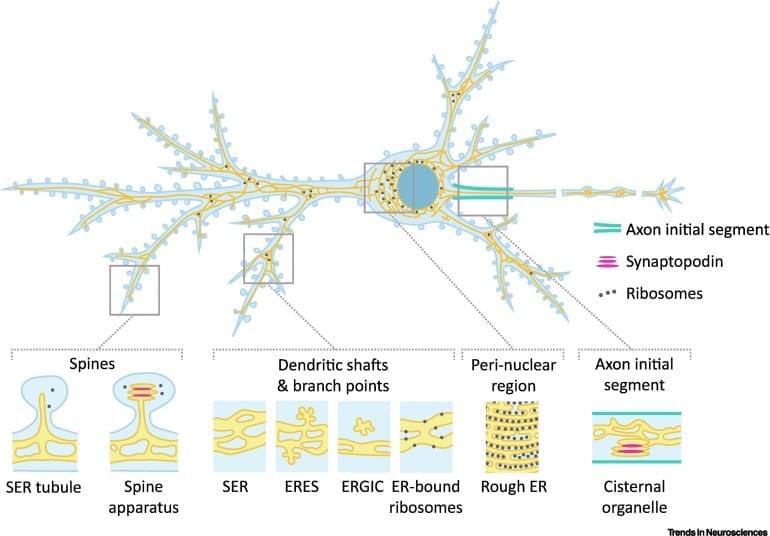The US has moved to restrict export of EDA software. What is it, and how will the move affect China?
The heterogeneity of the endoplasmic reticulum (ER) makes it a versatile platform for a broad range of homeostatic processes, ranging from calcium regulation to synthesis and trafficking of proteins and lipids. It is not surprising that neurons use this organelle to fine-tune synaptic properties and thereby provide specificity to synaptic inputs. In this review, we discuss the mechanisms that enable activity-dependent ER recruitment into dendritic spines, with a focus on molecular mechanisms that mediate transport and retention of the ER in spines.
Image credit: Max Planck Institute of Plasma physics. Cutaway of a Fusion Reactor.
A team of researchers from the Max Planck Institute for Plasma Physics (IPP) and the Vienna University of Technology (TU Wein) have discovered a way to control Type-I ELM plasma instabilities, that melt the walls of fusion devices. The study is published in the journal Physical Review Letters.
There is no doubt that the day will come when fusion power plants can provide sustainable energy and solve our persistent energy problems. It is the main reason why so many scientists around the world are working on this power source. Power generation in this way actually mimics the sun.
A parasite takes advantage of a nice person they have no respect for the person this happens a lot especially with people from other countries who call themselves your friends.
There was only one rule. Work hard and be nice, and everything would go just fine. That should be the rule for life, too… But, of course, that wasn’t how […] More.
A basement renovation project led to the archaeological discovery of a lifetime: the Derinkuyu Underground City, which housed 20,000 people.
Laya Joshua from Kerala has used stones, old wood, and many such eco-friendly elements to build her dream sustainable home, for which no trees were cut.
The consistency and vulnerability of the brain is demonstrated along with the clear and glistening pia and arachnoid and the tough dura. The cushioning function of the CSF is stressed and the features are pointed out on the ventral surface. The uncus and temporal lobes are normal with arteries free of atherosclerosis.
This is 2 of a series of 26 videos to be viewed in the suggested order or intermixed with other curricular materials. The entire series can be accessed here:
https://neurologicexam.med.utah.edu/adult/html/brain-dissections.html.
The videos may be downloaded in various formats by going here:
https://neurologicexam.med.utah.edu/adult/html/download_instructions.html.
Password Request form for downloadable Neuroanatomy Brain Dissection videos here: https://library.med.utah.edu/neuro-exam/
Autopsy of Unfixed Brain.
Yefim Lavrentyev, Research Associate, Department of Pathology, School of Medicine, University of Utah.
Specimens.
Should We Seek Immortality?
Posted in evolution, food, life extension
Read the story: https://aperture.gg/blogs/the-universe/should-we-seek-immortality.
Merch: https://aperture.gg/merch.
Although we’ve been socialized to accept death as an inevitability, and live our lives knowing that its looming shadow will one day catch up with us, many of us might never really come to terms with it. Throughout our evolution, we’ve come up with ideas, beliefs and theories that attempt to shine a light deep into the cold, dark abyss of death to give ourselves a hope of continued living and everlasting existence. Could we really stop our cells from aging? If you could, would you want to be immortal?
Stay connected with Aperture:
Website: https://aperture.gg/
Instagram: https://www.instagram.com/theapertureyt/
Twitter: https://twitter.com/TheApertureYT
Check out our other channels:
What If: https://bit.ly/youtube-What-If.
How to Survive: https://bit.ly/how-to-survive-show.
Crazy Creatures: https://bit.ly/crazy-creatures-show.
Your Body On: https://bit.ly/your-body-on-show.
Origins of Food: https://bit.ly/origins-of-food.
Versus: https://bit.ly/versus-show.
WTF Did I Just Watch: https://bit.ly/wtf-did-i-just-watch.
Questions or concerns? Contact us at https://underknown.com/contact/
#aperture #immortality #life
The motor cortex controls the voluntary movement of muscles. It remains largely unclear why its electrical or magnetic stimulation can alleviate therapy-resistant chronic pain—albeit unreliably. An interdisciplinary research group at the Medical Faculty of Heidelberg (MFHD) has now tracked down the underlying mechanisms and nerve pathways in mice.
The scientists showed that certain nerve pathways of the motor cerebral cortex are indirectly connected to the emotion centers in the brain, process both pain-related information and emotions by direct activation, and thus reduce the sensation of pain. Consequently, the team not only defines a new brain circuit for neurostimulation in pain therapy, but also brings the brain’s own reward system into focus as a starting point for future treatments. The results are now published in the journal Science.
The research was conducted within the framework of CRC1158 “From Nociception to Chronic Pain,” whose spokesperson is Professor Dr. Rohini Kuner, Director of the Institute of Pharmacology at the MFHD.
Surgeons at New York University (NYU) have successfully transplanted genetically-engineered pig hearts into two brain-dead people, researchers said on Tuesday, moving a step closer to a long-term goal of using pig parts to address the shortage of human organs for transplant.









